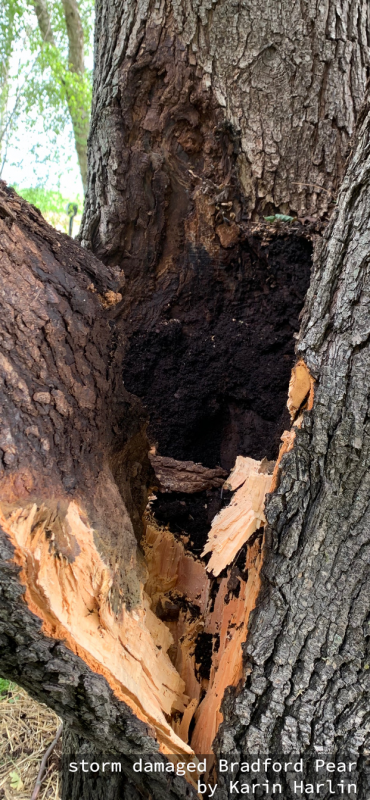With frequent summer thunderstorms, we should be diligent in scouting for tree issues that could become a larger problem. Proper preventative care can greatly increase a tree’s longevity.
Important first steps
Preparing a tree for weather-related disasters happens before the tree ever goes in the ground by making wise site and species selections. A tree in an unsuitable site can take years to fail, often time by which it’s a costly removal or worse- damage to persons or property.
- Consider all site conditions.
- Consider genetic characteristics of the tree.
- Ensure the species isn’t an aggressive non-native.
- Use proper planting techniques to improve chance of survival. Planting trees too deeply is a major problem in landscapes, and symptoms from being planted even 1 inch too deep can take years to become evident.
- Properly prune a young tree to be structurally sound. This mitigates chances of a mature tree failure by reducing the amount of structurally weak points in the canopy.
- Use mulch but keep it away from the trunk. Mulch will help with weed suppression, moisture retention, and returning organic matter to the soil. However, mulch must stay away from the trunk of the tree or the dark, damp environment will invite rot and undesirable pests and pathogens.
- Once decay is present around the base of the trunk, the structural integrity of that tree has been compromised and the potential for failure increases.
Preparing mature trees
How do you prepare for storms and the havoc they can wreak on trees? First realize that most tree health problems are environmental. Stressors affect the health of trees over many years, whether soil compaction, drought stress, temperature extremes, graft incompatibility, chemical or mechanical injuries, or- you guessed it- poor species selection. Rarely is the reason for a tree's failure limited to one issue, but usually a combination of factors. Some routines that we thought were beneficial- like using excessive fertilizers on the lawn- can be harmful to trees, especially during drought conditions. Scouting for symptoms and signs of tree health issues may save you a lot of trouble in the long run.
Look at the whole picture as well as the details
- Correctly identify the tree. This will narrow down possible afflictions by knowing what is normal for that species.
- Examine the site. Is a tree showing symptoms a year a two after a newly constructed driveway, sidewalk, or structure? The tree’s root zone, which is only 12 to 18 inches deep and extends 3-5 times past the canopy, was likely affected by that construction.
- Examine the foliage. Do symptoms appear at the top or bottom of the canopy? Is only one side or one branch affected? Are there weather-related conditions that may have caused foliage defects?
- Inspect the trunk and branches. Look for wounds, holes, cracks, cankers, weeping, oozing or anything else that look abnormal. Water sprouts or epicormic sprouting are an indication that the tree is experiencing stress. Look for dead branches, cracks or splits, or evidence of prior improper pruning practices such as topping. These will be weak points in the canopy with potential to fail.
- Inspect the roots and root collar. Look for girdling roots that wrap around the base of the trunk, which can hinder the vascular system of a tree. The presence of fungal growth in the root collar area is a definite indication of decay. This doesn’t always indicate immediate failure, but chances are increased, nonetheless.
- Insects and fungus are often secondary, meaning they move in and take advantage of an already stressed tree or present decay.
- Look for defects and decay. Codominant stems are very common and provide a weak point at which a tree can fail. This is why pruning when young is an important task.
Your tree has already experienced storm damage- what now?
Considerations when assessing a storm damaged tree include:
- Was the tree healthy before the damage?
- Are there major limbs broken?
- Is the main stem damaged or gone?
- Is at least 50% of the crown intact?
- How big are the tree wounds?
- Is the remaining portion structurally sound?
Make your decision to prune or remove the tree based on these factors. Hire a professional when necessary, tree and limb removal is dangerous work. Continue to mitigate future risk by evaluating established trees in the landscape for signs of stress regularly and prune dead and broken branches as needed.
